Eco-Printing on Wool Felt



Botanical printing combines historical methods used in natural dyeing with contact print techniques, and each piece is unique. When only natural pigments and fibers are used, it’s known as Eco-printing. The images and colors come from natural plant pigments and minerals from the earth, resulting in stunning plant portraits captured on fabric.
Wool felt is considered one of the oldest textiles on earth, and is made by interlocking wool fibers together through moisture and friction. A special affinity exists between eucalyptus leaves and wool felt, thus the brilliant colors achieved with the addition only of heat and water.
To create these pieces, eucalyptus and other leaves are layered onto moistened 100% wool felt, pressed tightly, or “bundled”, to achieve full contact, and steamed. During the steaming process, the plant’s pigments are transferred to the felt. Nothing matches the excitement of opening a finished bundle! No two pieces are ever the same.
These creations draw inspiration from the objects I observe and collect outdoors - a lifelong fascination. To me, this work is deeply satisfying and congruent with my desires to live more lightly on the Earth, pay attention to natural systems and forms, and surround myself with the beauty of nature’s images.
In this tutorial, you will learn two different types of Eco-printing techniques:
- Basic Technique: Perfect for beginners.
- Intermediate Technique: Well known to Eco-printing hobbyists.
Materials From The Felt Store:
Only 100% wool felt can be used, not acrylic. Wool is a protein fiber, like silk, and its characteristics are important to the process. The sheep are part of the creation! I prefer to use the 5mm Thick 100% Wool Designer Felt for these types of pieces, in Earth Wool White and Earth Raw White. For a budget-conscious option, white F-10 SAE Industrial Felt works well, and is slightly less dense.
Basic Technique
This technique is perfect for beginners who are new to the world of Eco-printing. You will learn how to create a basic Eco-print of eucalyptus on wool felt, in a size suitable for coasters, trivets, or table runners.
Materials Used:
- Wool felt
- Metal straight-edge or ruler
- Sharp utility knife
- Tweezers (optional) - Good for tiny leaves
- 2 Ceramic tiles (sized to match your piece)
- 2 Jumbo binder clips or 2 C-clamps (2-3 inch opening)
- Large, lidded pot with rack for steaming or a jar canner
- Oven mitts
- Kitchen tongs (optional)
- Eucalyptus - Available at your local florist or the flower section in grocery stores
- 2 Containers or buckets - One for soaking leaves, one for moistening your felt
- Clean, old towel


Instructions:
1. Using your sharp utility knife and metal straight-edge, cut your felt to the desired size - 4 inch squares for coasters, 4.5 inch squares for mug-sized, or trivets to suit your needs and fit your tiles.
Tip: To prevent the metal straight-edge from sliding on the felt, put a strip of masking tape on the underside. Careful not to trim your fingers! It takes approximately 2-3 passes to cut through 5mm thick felt.
2. Moisten the felt by placing it in a container of warm water and weighted, until no dry spots are left.


3. At the same time, grab a separate container of hot water, and soak your eucalyptus leaves, seeds, stems, etc.
4. When felt is thoroughly wetted, remove from water and blot dry. An effective way is to place it between double layers of towel, on the floor, and step on it with bare feet or soft-soled shoes, squeezing out excess water.
5. Make a tile, felt, eucalyptus sandwich:
- On your work table, place one tile, the same size or larger than your felt
- Place leaves on the tile
- Followed by a moist piece of felt
- Then more leaves
- Followed by another piece of felt
Repeat the layers, keeping the felt edges lined up. Finish with leaves and a tile.
Tip: When arranging the leaves, be meticulous and geometric, or random and natural – either way will work beautifully.





6. Press your sandwich, and secure it with either two jumbo binder clips (if you’ve used 2-3 felt pieces), or two C-clamps (up to 8 felt pieces). Screw the C-clamps firmly, there should be no wiggle or wobble.


7. Place the tightly clamped tile/felt stack into your steamer, 1-2 inches above the water level, and steam for 3 hours. If using C-clamps, make sure to carefully tighten the clamps periodically as the felt compresses.
Tip: I prefer to do this on an electric hot plate outdoors on the patio. In the kitchen is fine, but be aware that 3 hours of steam will add lots of moisture to the room - so a good exhaust fan is essential. After steaming indoors in the winter, my range hood began raining!
Important: Check inside the pot frequently, and make sure to keep a pitcher of water on hand to replenish the pot. You do not want the bottom of your pot to burn. Set your timer for 15 minutes to start, moving to 30 if the rate of water loss warrants it. Never leave it alone- remain nearby - meltdowns are a disaster!


8. Once the 3 hours of steaming is up, remove the clamped stack from steamer, place on a towel until cool enough to handle.
Now you’re ready for the reveal! Remove clamps and open the stack, observing how each type of leaf, stem, and seed printed, enjoying the smell of eucalyptus, and envisioning what you’d like to try on your next batch! Notice that facing felts are mirror images, and both sides of each felt are printed.


Remove excess water by blotting again with a clean, old towel, and place on a rack to dry. I use a laundry rack over a floor heating vent.
Tip: After drying, place the stack of finished felt pieces under a heavy book for a few days to flatten.



Intermediate Technique
In this part of the tutorial, you will learn how to add minerals to the basic technique to create prints with other types of leaves and flowers, many of which you can find on walks near home. This will expand the range of colors obtained from the leaves.
Beyond Eucalyptus
As we’ve seen, eucalyptus on wool gives a rich red-orange color; however, other varieties of leaves have distinctive forms and colors as well. When printing on wool felt with leaves such as oak, sumac, maple, etc. a mineral assist is needed to react with the tannins in the leaves. The intermediate instructions will walk you through the process.
Additional Materials Used:
- Fresh leaves. Good leaves for printing are:
- Oak
- Maple
- Liquidambar
- Sumac
- Rose
- Raspberry
- Fresh flowers. Good flowers for printing are:
- Coreopsis
- Marigold
- Bidens
- Cosmos
- Hibiscus
- Geraniums (some types)
- Gerbera
- Clematis (some types)
- Petunias
- Plain cotton or flannel fabric squares (4-10 pieces sized to fully cover felt squares)
- Plastic squares or used plastic bags with no printing (4-10 pieces sized to fully cover felt) - These will serve as barriers to prevent bleed-through of color.
- Iron “tea” (refer to notes below)
Notes:
Collected Leaves (not fresh): If you’re using collected pressed leaves, first re-hydrate them in warm water for at least an hour.
Flower Colors: Not all flower colors remain true through the Eco-printing process, and many are not “fast”, defined as lasting when subjected to washing, light, and time. Colors that are not fast are known as “fugitive”.
Plastic Barrier: While introducing plastic to this environmentally sustainable process is admittedly an anomaly, please use materials that would otherwise be destined for the landfill. These pieces can be re-used indefinitely. Alternatively, you may use sturdy paper, wetted, in place of plastic.
How to Make Iron "Tea": Made by soaking a handful of rusted iron (old nails, wire, pipe, etc.) in a quart jar of water with a splash of vinegar. Soak until you achieve a rusty brown color - approximately 1 week.
Tip: If you plan to pursue this lesson, start your iron solution now, giving it time to steep. At least a week of brewing is needed.


Instructions:
1. Follow steps 1, 2, and 4 in the Basic lesson, above.
2. Soak cotton squares for 10 minutes, or until thoroughly wetted, in a container holding part of your iron tea. Squeeze them gently, flatten, and place aside, ready to be used. These are referred to as “carrier cloths” or “iron blankets” and the felt is the “target”.
Tip: Use gloves when handling iron tea and iron blankets. If you do end up with iron stains (a slight darkening) on your fingers or surfaces, clean with lemon juice.

3. Starting on bottom tile, begin building the stack in this order:
- Felt
- Leaves/flowers
- Iron blanket
- Plastic barrier
4. Then, on the plastic barrier, reverse the order:
- Iron blanket
- Leaves/flowers
- Target felt
5. Repeat this process until you’ve reached your desired number of pieces, finish with the final top tile, and clamp tightly, as in Step 6 in the Basic lesson. The only difference is that you’ll have slight overhangs of iron blankets and barriers in this stack.






6. Steam the stack following step 7 in the Basic lesson, but only 90 minutes is needed - unlike eucalyptus which requires longer steaming to print well.
7. After 90 minutes, remove the stack, let it cool, and open, for the reveal!
You’ll see, as you open your stack, that not only the target felt has registered a print, but the iron blanket has also become a lovely plant portrait. These can be laundered and used in other craft projects, or re-used as an iron blanket. If your leaves and flowers have become firmly stuck to the fabric, simply allow them to dry and they’ll brush off.



Don’t be discouraged if some leaves and flowers print better than others. So many factors influence the printing properties of leaves – plant health, season, air quality, location, climate, soil, etc. You’ll determine your favorites as the seasons, and your skills, progress. Here are a few of my favorites.



Fascinating Leaf Fact
You may have noticed an amazing property of leaves that becomes apparent when printing - each side of a leaf prints differently! The top side, referred to the “sun side” of a leaf is generally not the side that gives the best print. It’s tougher to offer more protection for the leaf. The bottom side, or “moon side” of the leaf is the one that will give the best print, because it has the leaf’s breathing structures. Known as “stomata”, these openings allow entry of CO2 and the exit of oxygen and water vapor. They regulate the plant’s water loss and breathing by opening and closing, like microscopic mouths.
For this reason, placing a leaf moon side down, against the felt, will give the strongest and best-defined print, showing the leaf’s veins. More of the leaf’s pigments can escape from the moon side. The photos below show this difference, using felt that has been itself soaked in iron tea (no iron blanket) so that the leaves are in contact with the felt on their sun and moon sides. This makes for a very dark print, and a good illustration of the phenomenon. Eucalyptus is an exception to this rule; both sides print the same.


We invite you to share your thoughts on this process, questions, comments or tips and tricks. Don’t forget to show off your creations with #thefeltstore on social media. We love seeing the creations our customers come up with.
Chris Bentley, Island Studios
Instagram: @lchrisbentley
Facebook: @ColorsFromNature
 USA
USA CANADA
CANADA EUROPE
EUROPE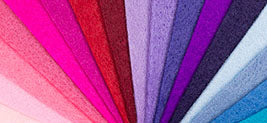
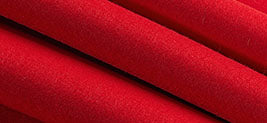
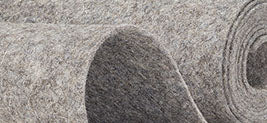
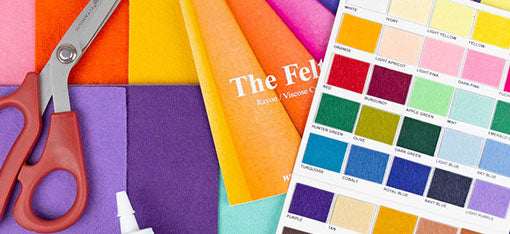
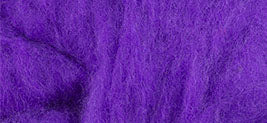
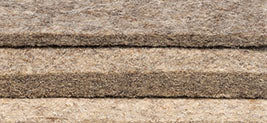
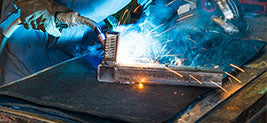
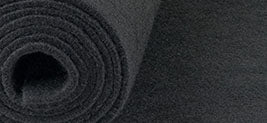
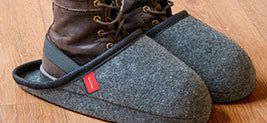
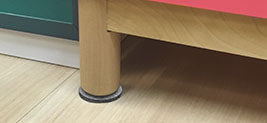
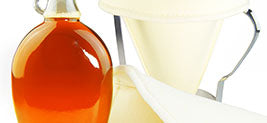
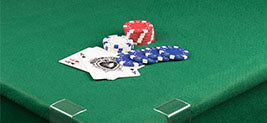




آموزش چاپ نمد خیلی خوب توضیح داده شده و خیلی یاد گرفتم ،در مورد ابریشم هم آموزش داشته باشید ممنون میشم
Thank you so much!! This was very clear and just what I was wanting to know, greatly appreciated
Thank you. The combination of photos and explanations were fantastic
Thank you for the clear instructions. I wonder how we can protect these beautiful coasters from wine stains, for example.
Do you have wool for needle felting?
Leave a comment